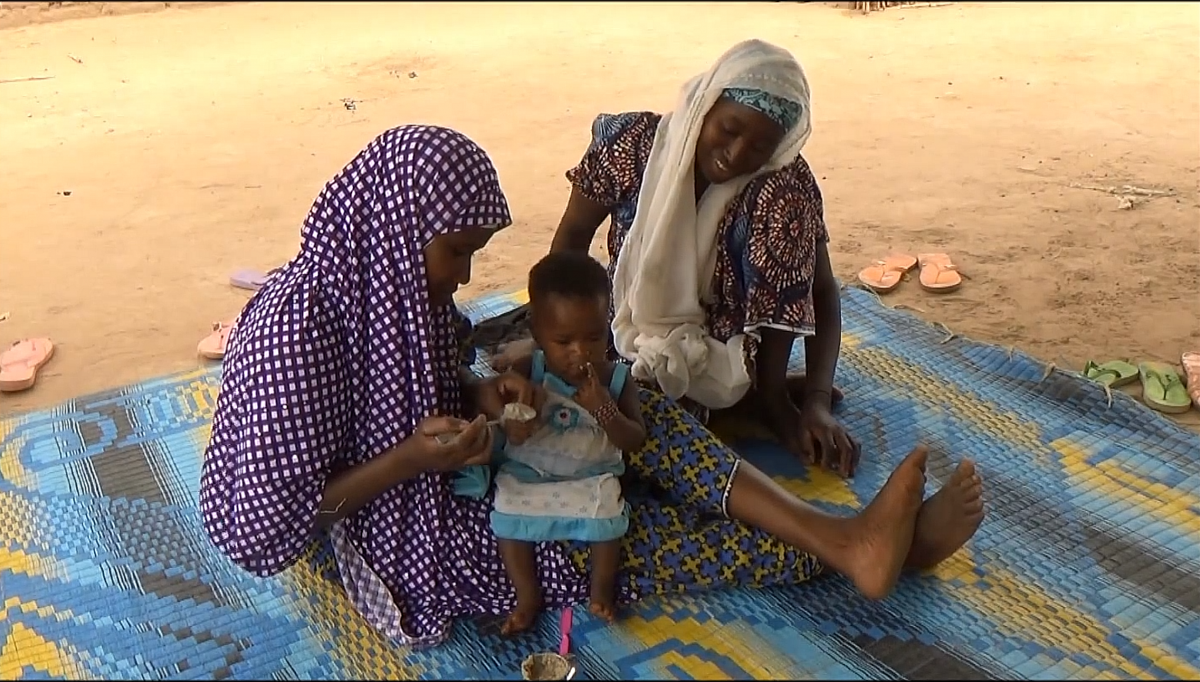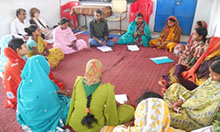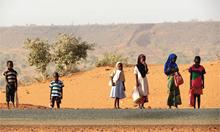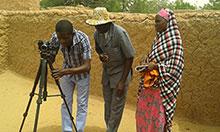 In September 2014, SPRING conducted formative research in Niger, which showed that young children were fed in a manner that may contribute to low calories and insufficient nutrition in young children’s diets. Feeding observations studied during the formative research included laissez faire (passive) style feeding often from a family pot, low response to the child’s demands, low dietary diversity, and thin consistency for complementary foods. Based on these findings, SPRING prioritized responsive feeding and feeding of young children from a separate plate as important behaviors to promote using our community video for nutrition approach. As part of SPRING’s commitment to building the evidence base for multi-sectoral nutrition, we conducted a mixed methods evaluation of the community video activity in Niger, which included developing and testing an indicator to measure feeding styles.
In September 2014, SPRING conducted formative research in Niger, which showed that young children were fed in a manner that may contribute to low calories and insufficient nutrition in young children’s diets. Feeding observations studied during the formative research included laissez faire (passive) style feeding often from a family pot, low response to the child’s demands, low dietary diversity, and thin consistency for complementary foods. Based on these findings, SPRING prioritized responsive feeding and feeding of young children from a separate plate as important behaviors to promote using our community video for nutrition approach. As part of SPRING’s commitment to building the evidence base for multi-sectoral nutrition, we conducted a mixed methods evaluation of the community video activity in Niger, which included developing and testing an indicator to measure feeding styles.
The nutrition community has made a call to identify indicators beyond stunting that can be used to assess holistic interventions for child growth and development, and to measure outcomes of integrated nutrition, health, and early childhood development interventions. Often caregivers interact most with children in the 1,000-day window during daily feeding times, and there is growing evidence that responsive feeding practices are linked to improved nutrition outcomes for children aged 6-23 months, a period that has been shown to be critical to brain development.
The 2016 Lancet Early Childhood Development Series defines nurturing care as “health, nutrition, security and safety, responsive caregiving, and early learning provided by parent and family interactions, and supported by an environment that enables these interactions,” and emphasizes its importance for child health and development. The internationally recognized 2001 WHO Guiding Principles for Complementary Feeding the Breastfed Child affirm that responsive feeding behaviors are a critical component of nurturing care, yet there is no standard indicator to measure responsive feeding practices. This is the only guiding principle included in this seminal document without associated globally-recognized indicators. A standard responsive feeding indicator would elevate the importance of responsive feeding as a critical behavior to improve dietary diversity and nutrition through nurturing care.
In response to this need, SPRING used the community video assessment as an opportunity to test an indicator for feeding styles as a responsive feeding behavior. After conducting research of the available responsive feeding assessment tools, the evaluation team selected the Caregiver’s Feeding Style Questionnaire (CFSQ), a survey that is able to assess positive encouragement for feeding and that is used in the US, but has not been widely tested in developing countries.
Our objective was to test this indicator to measure feeding styles in the developing country context of Niger, and to provide learning to determine if this indicator could be appropriate for use at a global level. Responsive feeding behaviors, along with nine additional MIYCN behaviors, were promoted through a community video for nutrition approach in select villages in Maradi region of Niger. SPRING-trained facilitators showed a community-produced video and led a discussion in community groups (mother support groups, husband’s schools, adolescent groups, and women’s groups) to promote good responsive feeding behaviors as part of effective complementary feeding. Data on knowledge and practices were collected at three points: prior to the video screening, approximately one month after the screening, and two to four months after the screening. The findings showed an increase in responsive feeding behaviors after exposure to the video and that adoption of recommended behaviors continued to increase approximately two months after seeing the video.
SPRING’s findings on the use of the CFSQ as an indicator for responsive feeding behaviors shows that the CFSQ provides a reliable measure of feeding styles for the resilience context of Niger. While the child feeding style questionnaire (CFSQ) was designed to assess nutrition behaviors, it may also provide a valuable opportunity to strengthen linkages between nutrition and early childhood development programs. There are currently very few indicators available to collect information on the care of very young children; future research should consider exploring the potential of responsive feeding of infants and young children on early childhood development. Based on these outcomes, promoting and increasing the use of the CFSQ indicator represents an opportunity for the global community to elevate the importance of responsive feeding as a critical nutrition practice to improve health and development in early childhood.


